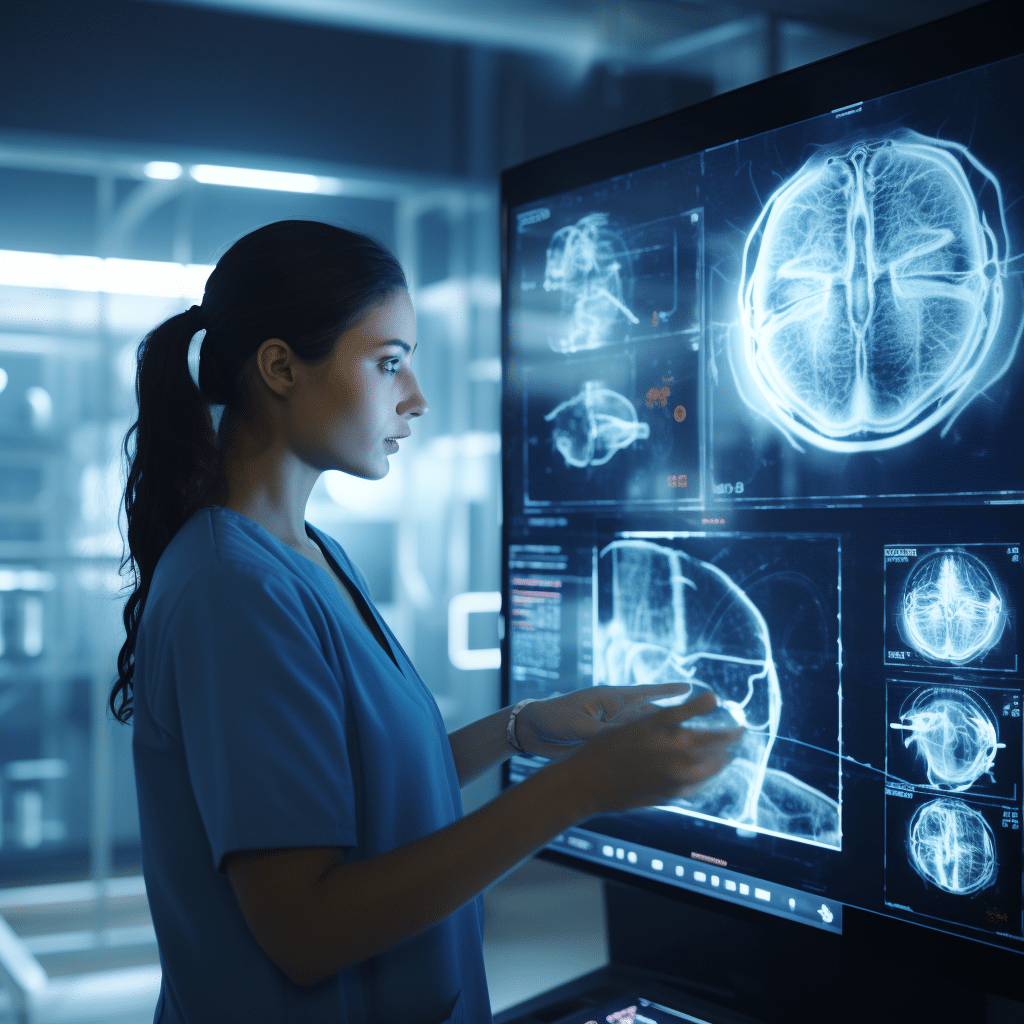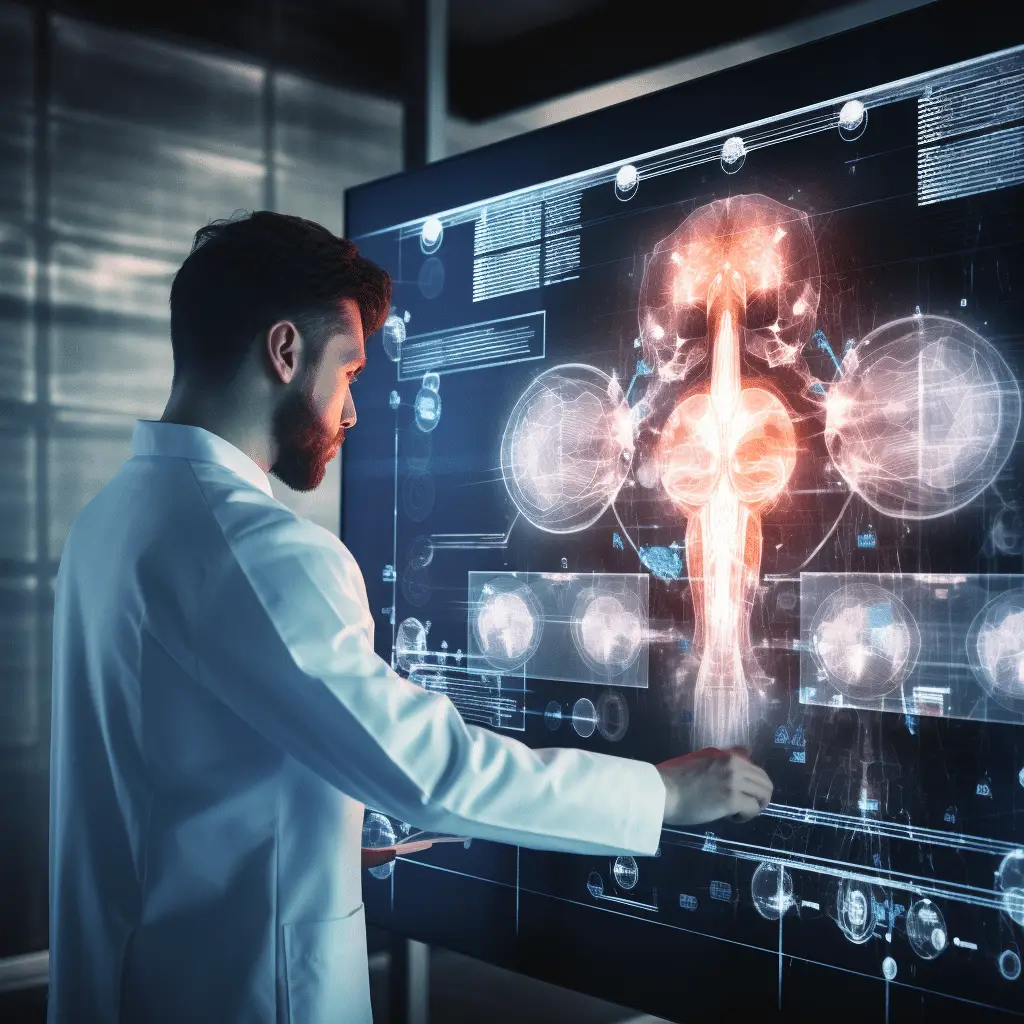
In recent years, the field of medical imaging and diagnostics has witnessed dramatic advancements with the integration of artificial intelligence (AI) technologies. These breakthroughs have revolutionized the way healthcare professionals diagnose and treat patients, enhancing accuracy, efficiency, and patient outcomes.

Improved Accuracy and Efficiency
AI algorithms have demonstrated their ability to analyze medical images with unprecedented precision. By leveraging deep learning algorithms and neural networks, AI has the capability to identify patterns in medical images that may not be immediately apparent to the human eye.
AI-powered software can detect cancers, lesions, and abnormalities in mammography, CT, and MRI scans, enabling early detection and prompt treatment. By processing vast amounts of data quickly, AI systems can reduce picture interpretation time and enable healthcare practitioners to make educated decisions faster.
Personalized Medicine and Treatment
Artificial intelligence (AI) not only helps in the medical diagnosis process, but it also helps in creating individualized treatment programs.
This helps healthcare professionals tailor treatment plans, optimizing outcomes for each patient based on their unique characteristics.
Additionally, AI algorithms can predict disease progression and assess patient response to treatment. By continuously learning from patient data, AI systems can adapt and refine their predictions, enabling more accurate prognosis and personalized recommendations.
Image Enhancement and Restoration
AI is changing medical imaging beyond diagnosis and treatment. It also improves the clarity and quality of medical photographs. AI algorithms can improve image contrast, decrease noise, and restore details, enabling healthcare professionals to better visualize anatomical structures and abnormalities.
AI breakthroughs allow for the merging of several imaging modalities, such PET-CT or MRI-PET, providing more comprehensive diagnostic information. By incorporating imaging data, AI algorithms enhance clinicians’ comprehension of patient conditions, leading to more accurate diagnoses and treatment recommendations.

Challenges and Future Directions
While AI has shown remarkable potential in medical imaging and diagnostics, there are still challenges that need to be addressed. Data privacy and security concerns, regulatory requirements, and ethical considerations are prime examples. Ensuring AI algorithms are transparent, trustworthy, and validated with rigorous clinical trials is essential to gain widespread acceptance and adoption in the medical community.
Looking ahead, the future of AI in medical imaging and diagnostics holds promising possibilities. Advanced machine learning techniques, including reinforcement learning and unsupervised learning, are being explored to further improve accuracy, efficiency, and personalized medicine. AI technologies integrated with augmented reality (AR) and virtual reality (VR) could also revolutionize medical education and procedural training.
Advancements in AI are opening new horizons in the field of medical imaging and diagnostics, empowering healthcare professionals with powerful tools to improve accuracy, efficiency, and patient care. As AI continues to evolve and be integrated into medical practices, it has the potential to revolutionize healthcare delivery and provide better outcomes for patients worldwide.
How is AI being utilized in medical imaging and diagnostics to improve accuracy and efficiency?
AI is being used in medical imaging and diagnostics to improve accuracy and efficiency in several ways:
1. Image analysis: AI algorithms can analyze medical images, such as X-rays, CT scans, and MRIs, to quickly detect abnormalities and provide diagnostic insights. This helps radiologists and clinicians in detecting diseases like cancer, cardiovascular diseases, or neurological disorders early on.
2. Computer-aided detection (CAD): AI-based CAD systems can aid radiologists by highlighting potential areas of concern in medical images. This assists in speeding up the process and reducing the chances of human error, leading to improved accuracy and efficiency in diagnostics.
3. Predictive analysis: AI algorithms can analyze a large amount of patient data, including medical records, lab results, and imaging data, to identify patterns and predict outcomes. This can help physicians make early and accurate diagnoses, as well as predict the probability of diseases or complications.
4. Treatment planning: AI algorithms can analyze medical images to assist in treatment planning. For example, in radiation therapy, AI can help create treatment plans by analyzing patient images and identifying optimal radiation doses and locations, improving precision and reducing side effects.
5. Precision medicine: By analyzing large datasets and incorporating genomic information, AI can assist in personalized treatment plans. It can identify biomarkers, genetic variations, and suggest the most effective medications or interventions for individual patients, thus improving accuracy in treatment decisions.
6. Workflow optimization: AI algorithms can automate routine tasks, such as triaging and prioritizing imaging studies, freeing up time for radiologists and clinicians to focus on complex cases. This helps streamline the workflow and improves efficiency in medical imaging and diagnostics.
Overall, AI has the potential to enhance accuracy, reduce human error, and improve the efficiency of medical imaging and diagnostic processes, leading to better patient outcomes.
What recent advancements in AI have been made specifically for medical imaging and diagnostics?
There have been several advancements in AI in the field of medical imaging and diagnostics. Here are some notable ones:
1. Automated Detection and Diagnosis: AI algorithms have been created to automatically detect diseases and abnormalities in medical pictures like X-rays, MRI, CT scans, etc. These algorithms can help radiologists pinpoint problem areas, which speeds up the diagnostic process.
2. Tumor Detection and Segmentation: AI models have been trained to identify and segment tumors from medical images. This assists in tumor detection, tracking growth, surgical planning, and monitoring treatment response.
3. Computer-Aided Diagnosis (CAD): AI-based CAD systems are being used to aid radiologists in interpreting medical images. These systems provide automated analysis and help detect early signs of diseases such as cancer, cardiovascular issues, Alzheimer’s, etc.
4. Predictive Analytics: AI algorithms can analyze medical images and patient data to predict the likelihood of certain medical conditions or diseases. This helps in early intervention, personalized treatment planning, and improving patient outcomes.
Image Reconstruction:
AI techniques like deep learning can reconstruct high-quality medical images from low-dose or low-quality scans. This reduces radiation exposure and enhances image clarity, improving diagnostic accuracy.
In radionics, artificial intelligence is used to analyze the texture, shape, and other properties of medical images in order to extract quantitative data.
These AI innovations in medical imaging and diagnostics have the potential to greatly improve healthcare in terms of precision, efficiency, and availability.
How does AI contribute to early detection and diagnosis of diseases through medical imaging?
AI contributes to early detection and diagnosis of diseases through medical imaging by leveraging machine learning algorithms and deep learning techniques to analyze and interpret medical images. Here are some ways AI aids in this process:
1. Automated Image Analysis: AI algorithms can quickly analyze large amounts of medical images such as X-rays, CT scans, MRI scans, or mammograms to identify abnormalities or patterns indicative of specific diseases.
2. Pattern Recognition: AI algorithms excel at recognizing patterns and anomalies in medical images that may be difficult for human radiologists to detect.
3. Enhanced Accuracy: The use of AI can significantly reduce human errors and false negatives or false positives in disease detection. It can act as a second opinion, assisting radiologists in making more accurate diagnoses.
Efficiency and Speed:
Faster diagnosis and shorter wait times for patients are both possible because to the ability of AI algorithms to process medical images at a far higher speed than human experts. This speed is especially important in life-or-death situations like spotting the early warning signs of cancer or a stroke.
By evaluating medical photos, AI systems can spot early warning signals of diseases, allowing for timely diagnosis and treatment. Treatment outcomes can be enhanced, and lives may be saved, thanks to this early discovery.
Artificial intelligence can mine through mountains of patient data, looking for patterns and correlations between, say, medical imaging and disease outcomes.
These insights can aid in predicting disease progression, treatment response, and personalized medicine.
Telemedicine and Remote Diagnosis: AI-assisted medical imaging allows for remote diagnosis, especially in areas with limited healthcare access.
It is important to note that AI is not intended to replace healthcare professionals but rather act as a valuable tool to support and enhance their capabilities in disease detection and diagnosis.








